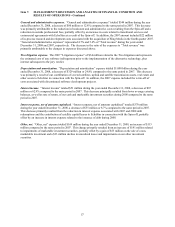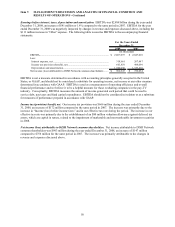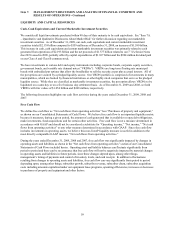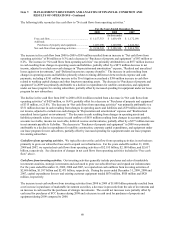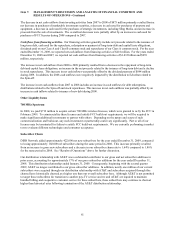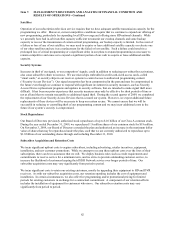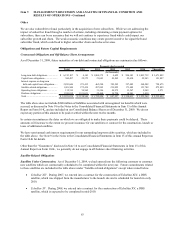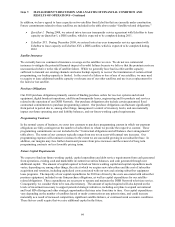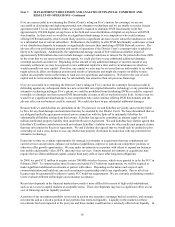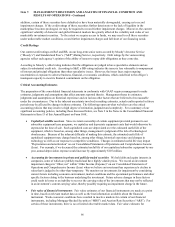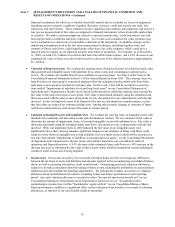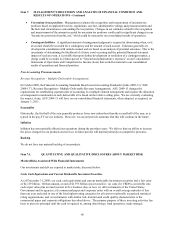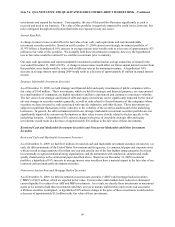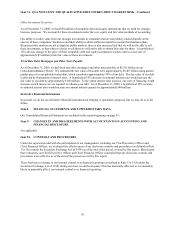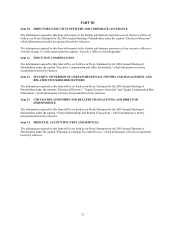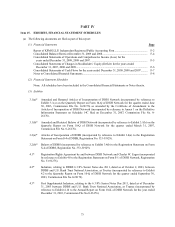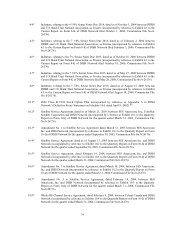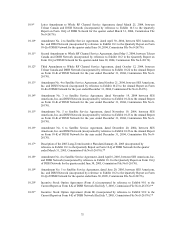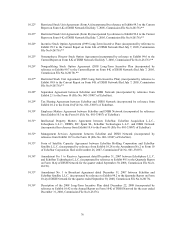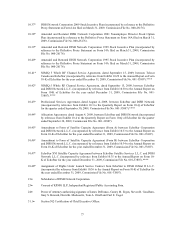Dish Network 2009 Annual Report Download - page 77
Download and view the complete annual report
Please find page 77 of the 2009 Dish Network annual report below. You can navigate through the pages in the report by either clicking on the pages listed below, or by using the keyword search tool below to find specific information within the annual report.Item 7. MANAGEMENT’S DISCUSSION AND ANALYSIS OF FINANCIAL CONDITION AND
RESULTS OF OPERATIONS - Continued
67
financial instruments for which no or limited observable market data is available are based on judgments
regarding current economic conditions, liquidity discounts, currency, credit and interest rate risks, loss
experience and other factors. These estimates involve significant uncertainties and judgments and may be a
less precise measurement of fair value as compared to financial instruments where observable market data
is available. We make certain assumptions related to expected maturity date, credit and interest rate risk
based upon market conditions and prior experience. As a result, such calculated fair value estimates may
not be realizable in a current sale or immediate settlement of the instrument. In addition, changes in the
underlying assumptions used in the fair value measurement technique, including liquidity risks, and
estimate of future cash flows, could significantly affect these fair value estimates, which could have a
material adverse impact on our financial position and results of operations. For example, as of December
31, 2009, we held $113 million of securities that lack observable market quotes, and a 10% decrease in our
estimated fair value of these securities would result in a decrease of the reported amount by approximately
$11 million.
x Valuation of long-lived assets. We evaluate the carrying value of long-lived assets to be held and used, other
than goodwill and intangible assets with indefinite lives, when events and circumstances warrant such a
review. We evaluate our satellite fleet for recoverability as one asset group. See Note 2 in the Notes to the
Consolidated Financial Statements in Item 15 of this Annual Report on Form 10-K. The carrying value of a
long-lived asset or asset group is considered impaired when the anticipated undiscounted cash flows from
such asset or asset group is less than its carrying value. In that event, a loss will be recorded in a new line
item entitled “Impairments of indefinite-lived and long-lived assets” on our Consolidated Statements of
Operations and Comprehensive Income (Loss) based on the amount by which the carrying value exceeds the
fair value of the long-lived asset or asset group. Fair value is determined primarily using the estimated cash
flows associated with the asset or asset group under review, discounted at a rate commensurate with the risk
involved. Losses on long-lived assets to be disposed of by sale are determined in a similar manner, except
that fair values are reduced for estimated selling costs. Among other reasons, changes in estimates of future
cash flows could result in a write-down of the asset in a future period.
x Valuation of intangible assets with indefinite lives. We evaluate the carrying value of intangible assets with
indefinite lives annually, and also when events and circumstances warrant. We use estimates of fair value to
determine the amount of impairment, if any, of recorded intangible assets with indefinite lives. Fair value is
determined primarily using the estimated future cash flows, discounted at a rate commensurate with the risk
involved. While our impairment tests in 2009 indicated the fair value of our intangible assets were
significantly above their carrying amounts, significant changes in our estimates of future cash flows could
result in a write-down of intangible assets with indefinite lives in a future period, which will be recorded in a
new line item entitled “Impairments of indefinite-lived and long-lived assets,” on our Consolidated Statements
of Operations and Comprehensive Income (Loss) and could be material to our consolidated results of
operations and financial position. A 10% decrease in the estimated future cash flows or a 10% increase in the
discount rate used in estimating the fair value of these assets (while all other assumptions remain unchanged)
would not result in these assets being impaired.
x Income taxes. Our income tax policy is to record the estimated future tax effects of temporary differences
between the tax bases of assets and liabilities and amounts reported in the accompanying consolidated balance
sheets, as well as operating loss and tax credit carryforwards. Determining necessary valuation allowances
requires us to make assessments about the timing of future events, including the probability of expected future
taxable income and available tax planning opportunities. We periodically evaluate our need for a valuation
allowance based on both historical evidence, including trends, and future expectations in each reporting
period. Any such valuation allowance is recorded in either “Income tax (provision) benefit, net” on our
Consolidated Statements of Operations and Comprehensive Income (Loss) or “Accumulated other
comprehensive income (loss) within “Stockholders’ equity (deficit)” on our Consolidated Balance Sheets.
Future performance could have a significant effect on the realization of tax benefits, or reversals of valuation
allowances, as reported in our consolidated results of operations.


